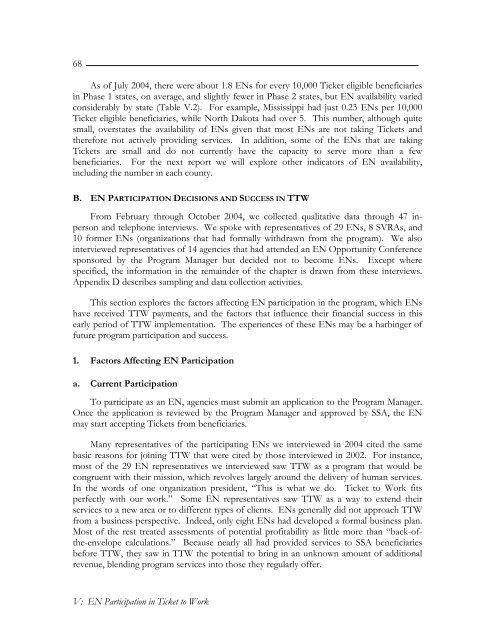Evaluation of the Ticket to Work Program, Implementation ...
Evaluation of the Ticket to Work Program, Implementation ...
Evaluation of the Ticket to Work Program, Implementation ...
You also want an ePaper? Increase the reach of your titles
YUMPU automatically turns print PDFs into web optimized ePapers that Google loves.
68As <strong>of</strong> July 2004, <strong>the</strong>re were about 1.8 ENs for every 10,000 <strong>Ticket</strong> eligible beneficiariesin Phase 1 states, on average, and slightly fewer in Phase 2 states, but EN availability variedconsiderably by state (Table V.2). For example, Mississippi had just 0.23 ENs per 10,000<strong>Ticket</strong> eligible beneficiaries, while North Dakota had over 5. This number, although quitesmall, overstates <strong>the</strong> availability <strong>of</strong> ENs given that most ENs are not taking <strong>Ticket</strong>s and<strong>the</strong>refore not actively providing services. In addition, some <strong>of</strong> <strong>the</strong> ENs that are taking<strong>Ticket</strong>s are small and do not currently have <strong>the</strong> capacity <strong>to</strong> serve more than a fewbeneficiaries. For <strong>the</strong> next report we will explore o<strong>the</strong>r indica<strong>to</strong>rs <strong>of</strong> EN availability,including <strong>the</strong> number in each county.B. EN PARTICIPATION DECISIONS AND SUCCESS IN TTWFrom February through Oc<strong>to</strong>ber 2004, we collected qualitative data through 47 inpersonand telephone interviews. We spoke with representatives <strong>of</strong> 29 ENs, 8 SVRAs, and10 former ENs (organizations that had formally withdrawn from <strong>the</strong> program). We alsointerviewed representatives <strong>of</strong> 14 agencies that had attended an EN Opportunity Conferencesponsored by <strong>the</strong> <strong>Program</strong> Manager but decided not <strong>to</strong> become ENs. Except wherespecified, <strong>the</strong> information in <strong>the</strong> remainder <strong>of</strong> <strong>the</strong> chapter is drawn from <strong>the</strong>se interviews.Appendix D describes sampling and data collection activities.This section explores <strong>the</strong> fac<strong>to</strong>rs affecting EN participation in <strong>the</strong> program, which ENshave received TTW payments, and <strong>the</strong> fac<strong>to</strong>rs that influence <strong>the</strong>ir financial success in thisearly period <strong>of</strong> TTW implementation. The experiences <strong>of</strong> <strong>the</strong>se ENs may be a harbinger <strong>of</strong>future program participation and success.1. Fac<strong>to</strong>rs Affecting EN Participationa. Current ParticipationTo participate as an EN, agencies must submit an application <strong>to</strong> <strong>the</strong> <strong>Program</strong> Manager.Once <strong>the</strong> application is reviewed by <strong>the</strong> <strong>Program</strong> Manager and approved by SSA, <strong>the</strong> ENmay start accepting <strong>Ticket</strong>s from beneficiaries.Many representatives <strong>of</strong> <strong>the</strong> participating ENs we interviewed in 2004 cited <strong>the</strong> samebasic reasons for joining TTW that were cited by those interviewed in 2002. For instance,most <strong>of</strong> <strong>the</strong> 29 EN representatives we interviewed saw TTW as a program that would becongruent with <strong>the</strong>ir mission, which revolves largely around <strong>the</strong> delivery <strong>of</strong> human services.In <strong>the</strong> words <strong>of</strong> one organization president, “This is what we do. <strong>Ticket</strong> <strong>to</strong> <strong>Work</strong> fitsperfectly with our work.” Some EN representatives saw TTW as a way <strong>to</strong> extend <strong>the</strong>irservices <strong>to</strong> a new area or <strong>to</strong> different types <strong>of</strong> clients. ENs generally did not approach TTWfrom a business perspective. Indeed, only eight ENs had developed a formal business plan.Most <strong>of</strong> <strong>the</strong> rest treated assessments <strong>of</strong> potential pr<strong>of</strong>itability as little more than “back-<strong>of</strong><strong>the</strong>-envelopecalculations.” Because nearly all had provided services <strong>to</strong> SSA beneficiariesbefore TTW, <strong>the</strong>y saw in TTW <strong>the</strong> potential <strong>to</strong> bring in an unknown amount <strong>of</strong> additionalrevenue, blending program services in<strong>to</strong> those <strong>the</strong>y regularly <strong>of</strong>fer.V: EN Participation in <strong>Ticket</strong> <strong>to</strong> <strong>Work</strong>
















